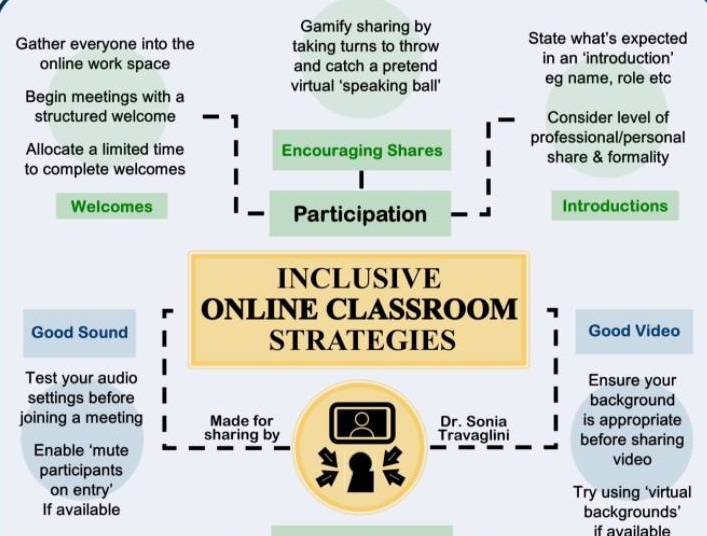Digital Diversity, Equity, and Inclusion in Online Learning: A Lesson Learned from Covid-19 Pandemic

The increasing use of digital technologies has transformed how we interact, relate to others, access, and consume information. Not only do digital technologies provide a way to connect with others across the globe, but innovation in this space also offers newly enhanced and expanded opportunities for citizens to participate in civic engagement more broadly directly. Educators and learners are in significant transformations in the teaching and learning arenas (Chapman, 2016). Chapman (2016) further elaborates on two kinds of change. The first transformation involves the increasingly ubiquitous ways digital technologies enable people to engage one another (Parson et al., 2009; Turkle, 2005, cited in Chapman, 2016). The second significant transformation is driven by the increasing cultural and cognitive diversity within classrooms, globally, and mainly within multiethnic societies.
Notably, a sudden shift in education occurred at the beginning of the Covid-19 pandemic regarding the use of technology. Teachers worldwide were expected to integrate technology in their classrooms to shift face-to-face meetings with online learning. Consequently, discrepancies in digital access and skills exist in education. For instance, students from rural and low-income communities have less access to broadband internet access. This fact is in line with Selwyn and Jandrić (2020), who claims that the pandemic has shone a light on a range of disparities, divides, and disadvantages associated with digital education.
Some studies have investigated digital diversity, equity, and inclusion in online learning. Some findings regarding digital inequalities were conducted by a group of researchers at the University of Ottawa. First, inequalities in access to the tools or reliable Internet connection needed to learn online. Second, inequalities in opportunities to develop digital literacy skills — the range of skills needed to navigate, create and participate online. Third, inequalities in power, as digital spaces can recreate social structures that limit participation or silence the voices of certain groups. Thus, not everyone has the same opportunities to develop their digital identity or the agility to participate fully as a digital citizen (Cotnam-Kappel & Woods, 2020), cited in The University of Ottawa, 2020).
Therefore, I raise this critical issue to address the following DEL course objectives and ISTE Standard 7 for Coaches (Digital Citizen Advocate):
- promoting diversity, cultural understanding, and global awareness by using digital-age communication and collaboration tools to interact locally and globally with students, peers, parents, and the larger community (Course Objective 4)
- Promoting strategies of social justice in order to help students and teachers achieve equitable access to digital tools, resources, and technology-related promising practices (Course Objective 5)
- Inspiring and encouraging educators and students to use technology for civic engagement and to address challenges to improve their communities (ISTE Standard 7a)
What is Diversity, Equity, and Inclusion?
Cited from Downs (2021), I will elaborate on the definitions of the respective terms: diversity, equity, and inclusion.
Diversity is “a synonym for variety. A diversity focus emphasizes ‘how many of these’ we have in the room, organization, etc. Diversity programs and cultural celebrations/education programs are not equivalent to racial justice or inclusion. It is possible to name, acknowledge, and celebrate diversity without doing anything to transform the institutional or structural systems that produce, and maintain, racialized injustices in our communities.” (YWCA, 2016).
Equity is “the effort to provide different levels of support based on an individual’s or group’s needs in order to achieve fairness in outcomes. Working to achieve equity acknowledges unequal starting places and the need to correct the imbalance.” (YWCA, 2016). There are two areas to consider regarding access to learning technologies: access to information and devices (Jones and Bridges, 2016). Meanwhile, equitable teaching means fair and just outcomes regardless of the students’ differences in the classroom.
Equity vs. Equality
It is also important to note that there is a fundamental difference between equity and equality. Whereas equality strives to provide everyone with the same resources and opportunities, equity recognizes that people need different resources to succeed. As the George Washington University Milken Institute School of Public Health writes, “Equality means each individual or group of people is given the same resources or opportunities. Equity recognizes that each person has different circumstances and allocates the exact resources and opportunities needed to reach an equal outcome” (Downs, 2021).
Inclusion refers to “a state of belonging when persons of different backgrounds and identities are valued, integrated, and welcomed equitably as decision-makers and collaborators. Inclusion involves people being allowed to grow and feel/know they belong. Diversity efforts alone do not create inclusive environments. Inclusion involves a sense of coming as you are and being accepted, rather than feeling the need to assimilate.” (KAPITAN, 2017)
In the context of pedagogy, inclusion refers to whether the courses are online, in-person, or a combination of the two. It asks us to consider how we can help all students succeed. For in-person classes, inclusive approaches include (but are not limited to) creating inclusive learning spaces where students feel valued and included, setting clear expectations about course work and deadlines, and making the learning and assessment accessible and relatable to all students. When in-person classes are canceled and learning shifts to online spaces and methods, these ideas can still be applied–but access and equity can look very different in online teaching contexts and become increasingly complicated when/if students are no longer on-campus (Rise University, 2021).
Pedagogical Implications: Teaching Principles, Guides, and Strategies
Some higher education institutions have shared best practices regarding teaching principles, guides, and strategies to minimize the discrepancies in education, particularly online learning during the pandemic. For example, Columbia University promotes principles of inclusive teaching to help students feel a sense of belonging, ensure they can access course materials, and support them in achieving learning goals. The current context calls for empathy and resilience on the part of both students and instructors (Columbia University, 2020). The five principles of inclusive teaching are outlined in the Guide for Inclusive Teaching at Columbia (Columbia University, 2020).
- Establish and support a class climate that fosters belonging for all students
- Set explicit student expectations
- Select course content that recognizes the diversity and acknowledges barriers to inclusion
- Design all course elements for accessibility
- Reflect on one’s beliefs about teaching (online) to maximize self-awareness and commitment to inclusion
Moreover, some teaching hacks are suggested by UC Davis (2020), as shown in Figure 1.

Figure 1: Inclusive Online Classroom Strategies (UC Davis, 2020)
There are six (6) inclusive online classroom strategies covering:
1. Ensure access: Evaluating equitable student access to technology tools
- Evaluate student access to computers, software, cameras, internet to ensure students can participate in online instruction.
- Evaluate student access to a place to participate in online courses (e.g., minimal distractions, quiet space, etc.).
- Review student accessibility needs; consider what diverse learning looks like for all students.
- Identify campus resources, as appropriate, to ensure students have access to technology requirements for successful participation in online classes.
2. Set the tone: Planning your syllabus
- Think about the climate you want to create for the class: welcome students and explain philosophies behind pedagogies, not punishment.
- Consider sharing some information about yourself, e.g., why do you enjoy teaching this class? What is your teaching philosophy?
- Consider flexibility in participation and attendance policies; include statements in the syllabus that consider extenuating circumstances for deadlines, exam dates, etc. (personal illness, family commitments, unexpected work hours, etc.).
- Identify free online texts and resources and use library reserve materials when possible
- Provide clear course goals/learning outcomes.
3. Build trust: Establishing a supportive class environment
- Start classes with short 2-3 min activities to reduce stress, calm anxiety, and help students to focus
- Seek feedback
4. Engage with content: Supporting in-class learning
- Focus content on main topics; critically evaluate what the most critical concepts for mastering course goals are.
- Break material into small chunks (5-10 min each) for synchronous or asynchronous formats.
- Use several quizzes, polls, iClickers, etc., to periodically check for learning and understanding—keep it fun too! It can be used with both synchronous and asynchronous formats.
- Pre-lecture quizzes can help identify areas that students aren’t understanding—use part of the next class to discuss quiz results and clarify misconceptions.
- Use smaller group discussions to engage students.
- Zoom can be set up to provide mini breakout rooms for students to discuss in small groups.
- Online discussion forums (e.g., in Canvas) can engage students with content outside of class time.
- Use written reflection exercises to assess learnings, apply knowledge, encourage connections to course materials, and allow students to express their interests, challenges, etc.
- Check frequently for understanding.
- Consider multiple opportunities for graded work rather than a small number of exams worth a high course grade percentage.
5. Create connections: Encouraging engagement outside of class time
- Establish online office hours, incentivize participation. If you record these office hours, you can then post them on Canvas for those who could not make the meeting.
- Create opportunities for online study groups; consider making this a requirement for the course. These can build study skills and help students to make connections to peers.
- Send individual emails to students with a C/C- or lower and encourage them to come for office hours.
6. Be kind to yourself and your students
- Do not expect perfection of yourself or students under situations with limited time for preparation.
- Model a growth mindset for your students—believe in the malleability of intelligence and use strategies to grow and develop your knowledge and skills
- Practice patience and flexibility.
San Diego State University provides another example. They make a guide providing suggestions and resources to help faculty continue teaching in equitable and inclusive ways as they move to teach face-to-face classes remotely (San Diego State University, 2021).
1. Be Accessible
There are three aspects of accessibility, including accessibility for students with physical impairments that may create challenges for reading/seeing/hearing digital files and content. Then, the accessibility for students with psychological and learning differences requires specific accommodations such as extra time to process materials or additional exam time—finally, the accessibility for students with limited access to computers or stable internet service.
2. Be Flexible and Open
The uncertainty and extreme nature of the current situation mean that faculty need to be somewhat flexible if they genuinely want to support all of our students. We do not always know what our students are going through, which may be particularly true once we regularly lose our ability to see them in our physical classroom. Moreover, as should be clear from most of the suggestions in this guide, an essential aspect of equitable and inclusive teaching, in general, is recognizing and working with the diversity of our students along multiple dimensions. As you move your course into a different modality, try to stay open to trying a few new things; you may find that one silver lining to this situation is that you discover new ways of teaching that are both better for your students and more enjoyable.
3. Be Identity-Conscious
A critical feature of equity-minded teaching is the acknowledgment that our students are NOT all the same, that they come to us with sometimes vastly different experiences and those experiences are often tied to their social identities (i.e., race, gender, sexual orientation, nationality, first-gen status, etc.). In the virtual environment, and at this particular moment, there are several ways that you can incorporate that acknowledgment into your course in meaningful ways.
4. Be Proactive and Intrusive
Although “conventional wisdom” is that students prefer virtual learning (as evidenced, for example, by the fact that online sections of courses will generally fill faster and well before face-to-face sections of the same courses), there are still plenty of our students who are self-aware enough to know that they do not perform as well in a virtual environment. One reason for this is that they know they may not have the self-motivation to keep up with the work without the accountability of a class to show up for. A well-designed virtual course will attempt to counteract this by building a great deal of structure and accountability, which you should strive to do as well. In addition, designing for equity and inclusion means being particularly proactive about supporting students who may need some extra attention.
5. Be Relational
While establishing supportive interpersonal relationships with students is one of the most fundamental tenets of effective teaching, it can be essential for students from traditionally underrepresented backgrounds. If you are moving from a face-to-face class, you have the advantage of already having had the opportunity to establish a personal connection with students; the challenge as you move into a virtual environment will be to maintain that connection.
6. Be Transparent
Faculty, who generally have advanced degrees and often have a high level of self-direction, can sometimes forget that our students are not us. Being inclusive means being mindful that not all of our students are well-versed in the hidden curriculum that faculty may take for granted. When we throw in the additional challenges of distance learning, we must work even harder to ensure that we are not making any unnecessary assumptions about what our students know and can do.
Specifically, the Center for Teaching Excellence at Rice University (2020) and proposed some choices to promote inclusion, equity, and access while teaching remotely as follows:
- Address unequal access to technology, hardware, and software
- Provide a balance between asynchronous and synchronous tools and course materials
- Create an environment that includes and values all students
A good intention is not sufficient to enhance or hinder classroom equity in online learning. Therefore concrete strategies are recommended to make your online/hybrid teaching more equitable. Here are three tools recommended by the Center for Teaching, Learning, and Technology at Illinois State University (2021).
This document is a guided reflection tool to consider inclusivity and equity in your online/hybrid courses. You can use examples of equitable and inclusive online/hybrid teaching practices as your strategies to make your course more inclusive and equitable.
2. Equity-minded Syllabus Review
A syllabus serves to encapsulate our teaching beliefs, values, and approaches, and this article challenges us to reflect on those attributes and engage in an equity-minded review. The exercises in this article will help you better understand whom your syllabus serves and does not and how you can change it to promote the equity-minded practice.
3. Peralta Online Equity Rubrics
This rubric is composed of eight (8) criteria that you can use to evaluate your course in terms of inclusion and equity. The companion document describes “How You Can Start Addressing This Equity Issue” for every eight criteria.
To conclude, I go for the professional development given to teachers since it is critical to the successful integration of digital resources into the learning enterprise. Teachers can share their best practices on minimizing digital discrepancies and skills through a professional learning community. Chapman (2016) stated that professional development should include sessions on learning to operate the learning technology. Instruction on incorporating the technology into lesson planning and lesson delivery activities must be part of any professional development efforts. This richness of training equips educators to reap the benefits of technology and explore how to incorporate it into their teaching practice.
References:
Chapman, R. (2016). Diversity and Inclusion in the Learning Enterprise: Implications for Learning Technologies. In N. J. Rushby and D. W. Surry (Eds.), The Wiley Handbook of Learning Technology (pp. 287-300). Wiley Blackwell.
Columbia University. (2020). Guide for Inclusive Teaching at Columbia. https://cpb-us-w2.wpmucdn.com/edblogs.columbia.edu/dist/8/1109/files/2020/02/Guide-for-Inclusive-Teaching-at-Columbia_Accessibility-Revisions_15-January-2020_FINAL.pdf
Jones, M, and Bridges, R. (2016). Equity, Access, and the Digital Divide in Learning Technologies: Historical Antecedents, Current Issues, and Future Trends. In N. J. Rushby and D. W. Surry (Eds.), The Wiley Handbook of Learning Technology (pp. 327-347). Wiley Blackwell.
Downs, L. R. (2021, August 5). Diversity, Equity, and Inclusion and Digital Learning. WCET Frontiers. https://wcetfrontiers.org/2021/08/05/dei-and-digital-learning/
Illinois State University. (2021). Diversity, Equity, and Inclusion in Online Courses. https://ctlt.illinoisstate.edu/pedagogy/diversity/online/
Rice University. (2020). Inclusion, Equity, and Access While Teaching Remotely. Reflections on Teaching and Learning. The CTE Blog.
San Diego State University. (2021). Maintaining Equity and Inclusion in Virtual Learning Environments. https://sacd.sdsu.edu/cie/cie-resources/maintain-equity-inclusion
Selwyn, N., and Jandrić, P. (2020). Postdigital Living in the Age of Covid-19: Unsettling What We See as Possible. Postdigital Science and Education 2, 989–1005. https://doi.org/10.1007/s42438-020-00166-9
The University of Ottawa. (2020, August 12). The Evolution of Distance Education and Issues of Digital Equity and Inclusion. https://education.uottawa.ca/en/news/evolution-distance-education-and-issues-digital-equity-and-inclusion
UC Davis. (2020). Easy Teaching Hacks to Support Equitable Practices with Online Instruction. https://keepteaching.ucdavis.edu/sites/g/files/dgvnsk8756/files/files/page/Teaching%20Hacks%20to%20Support%20Equitable%20Teaching%20in%20On-line%20Courses_March2020%5B11%5D.pdf



Mun Shing Cheong
Hi Ignas, COVID-19 has indeed not only brought to light the need for digital transformation in education but also raises up the issue of digital equity when it comes to access to technology for low-income communities. I appreciate that you have taken the time to define inclusion, equity, and equality and have highlighted that equity does not in fact equate to equality. Thank you for the practical strategies, suggestions, and tools for ensuring a more inclusive and equitable classroom. Very useful!
Chelly Rody
Hello Ignas! I have learned a lot from your post. You have cited some excellent resources and posted a lot of useful strategies for teachers. I know many of these strategies apply more towards older students, but I have connected a lot of your ideas to my own context. I love this statement: A good intention is not sufficient to enhance or hinder classroom equity in online learning. We need to put our intentions into action.